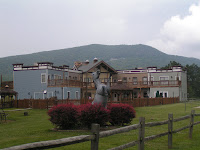
It seems we finally found summer…or it found us! Most of the time it’s been in the 90s and humid here in Front Royal. Originally we were only going to spend 3 nights at Skyline Ranch Resort (entrance and clubhouse in photo at left), then move about 6 miles down the road to North Fork Ranch Resort for the next 7, but we drove over the day after arriving here, and l

iked this one better so were able to extend our stay and cancelled the other reservation. Animals seem to abound at Skyline Resort. They have a petting zoo complete with two goats, a miniature horse, 2 pot belly pigs, and 3 ducks. There’s also a stable where some resort members board their horses, and these folks were out rid

ing the day we arrived. Our neigh
bor, Wayne, has a 12 week old Jack Russell Terrier named Daisy, who is an absolute doll and full of energy, and a couple sites down Susie walks her 3 year old cat, Xena, every evening!

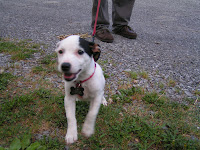
Our rig is situated in a nice shady spot that’s able to get satellite reception, and we have a view of the Blue Ridge Mountains and Skyline Drive in the distance. The shot on the left is from our rig looking out the front window at that range, while the shot on the right is from about that same spot up there on
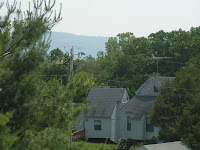
the mountain looking down towards our campground.

 Fri. we drove to the north entrance of the Shenandoah National Park (just 15 min. away) and 5 miles up to the Visitor Center. Naturally we watched the film called “Experience Shenandoah”, and they had many well done displays showing the various wildlife and topography of the Park. We stopped at one overlook on the way to the center but planned to return a coup
Fri. we drove to the north entrance of the Shenandoah National Park (just 15 min. away) and 5 miles up to the Visitor Center. Naturally we watched the film called “Experience Shenandoah”, and they had many well done displays showing the various wildlife and topography of the Park. We stopped at one overlook on the way to the center but planned to return a coup le days later with the dogs so didn’t drive any further.
le days later with the dogs so didn’t drive any further.
The weekend was so hot we decided to stay close to the A/C, and Tues. morning loaded the dogs in the car to head for the Park. Shenandoah National Park, established in 1935, consists of Skyline Drive, a narrow mountain road that runs 105.5 miles  along the Blue Ridge Mountains. Though we drove only 30 miles on this trip, the views were spectacular, and the mountain laurel was in full bloom. The mountains of Shenandoah National Park contain some of North America’s oldest rock formations and are home to more plant species than all of Europe, including 100 tree and more than 900 wildflower species.
along the Blue Ridge Mountains. Though we drove only 30 miles on this trip, the views were spectacular, and the mountain laurel was in full bloom. The mountains of Shenandoah National Park contain some of North America’s oldest rock formations and are home to more plant species than all of Europe, including 100 tree and more than 900 wildflower species.

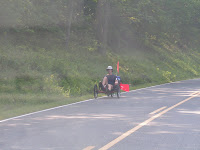
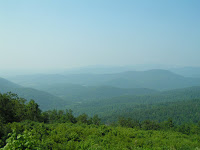
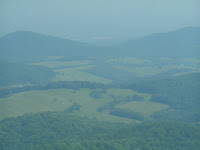
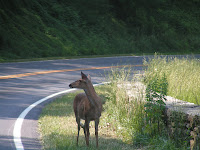 As we drove, we saw deer in four different spots, either crossing the road or right along side it as we passed.
As we drove, we saw deer in four different spots, either crossing the road or right along side it as we passed.
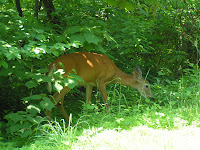

The Blue Ridge Mountains are the easternmost range of the Appalachians. There are scenic overlooks all along the Drive, and the Appalachian Trail crosses it 28 times covering 95 miles. One of the spots is the Little Hogback Overlook at 3,035 feet, and it was here we decided to take the dogs for a walk on the Trail. The A.T., as they call it, stretches more than 2,100 miles
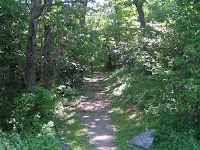
from Maine to Georgia, and you can recognize it by white blazes (rectangles) painted on trees at evenly spaced intervals. Double blazes indicate a significant change of direction. I think the dogs were on sensory overload with all the smells, and the gnats were heavy in spots. We only walked about a quarter mile of the A.T., but it was excit

ing! As we were heading back to the car, both dogs sensed something off to the side down the trail, and before we knew it, a big black bear ran across our path about 40 feet ahead of us!! Both dogs went nuts and were ready for the chase. We couldn’t shut Abby up as she kept barking and whining pulling at her leash. Mikey barked and pulled at the leash but wasn’t as vocal as Abby…he was more stalking! Russ figure
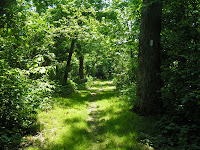
s the bear was about 5’-6’ long and 3’-4’ to the shoulders on all fours. It all happened so fast there was no way to get a picture, but it was definitely an experience to be remembered.


Wed. morning we headed for Manassas National Battlefield Park (
http://www.nps.gov/archive/mana/home.htm) located here in VA. Two Civil War battles were fought here near a little stream called Bull Run. In fact we learned that the Confederates referred to them as the Battles at Manassas while the Union called them the Battles at Bull Run. The first battle in the summer of 1861 is considered the first major battle of the war and was a decisive Confederate victory. The second battle occurred 13 months later on basically the same ground and was another Confederate victory.
As a walking tour was to begin shortly after we arrived, we didn’t watch the film f
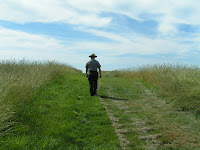
irst but instead met the park ranger at Matthews Hill, where much of the battle occurred the morning of July 21, 1861, during what is referred to as First Manassas (First Bull Run). Troops on both sides were enthusiastic, dressed in their colorful new uniforms, and confident that their foes would run at the first shot. Both sides believed that the war would be short and would only require one battle to bring victory. So confident was the northern army that Union troops were consigned for only a 90-day stint. The ranger began his talk at the base of the hill pointing out strategic spots on the map as he spoke, and then it
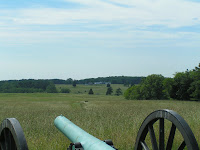
was time to walk the same path the Union soldiers took so many years before. The view was nearly as it had been back then though a path had been mowed through the wheatgrass like those men had marched through. Those Union soldiers had been marching since 2 a.m. and stumbling through the dark, had reached this point much later than expected. After intense fighting, the Confederate troops were pushed back to Henry Hill, and both sides were stunned by the violence and destruction they had just encountered. It was about noon, and the Union troops stopped their advance to reorganize. Pictured at the left is the view from the top of Matthews Hill looking towards the house at Henry Hill.
At this point, we went back to the visitor’s center for the next walking tour at

Henry Hill. About an hour after the Union troops had stopped, the fighting began again each side trying to force the other off the hill. The battle lasted all afternoon until fresh Southern units crashed into the Union right flank scattering the tired and scared soldiers. No one knew that Mrs. Judith Henry, her daughter, son, and servant were still in the little wood house on that hill. The bedridden Mrs. Henry was the only civilian killed in that first battle. Near the reconstructed house stands a monument that reads “In memory of the Patriots who fell at Bull Run, July 21, 1861”. Though this battle is where Gen. Thomas Jackson received his nickname when Brig. Gen. Bee shouted, “There

stands Jackson like a stone wall!”, and the Confederates were victorious, nearly 900 young men lost their lives that day. In all the fighting lasted 10 hours and pushed aside all notions that this would be a quick war.
We returned to the visitor’s center for the 45-minute film, “Manassas: End of Innocence”, that covers both battles. Then we toured the exhibits that display artifacts from the First Manassas. One of the exhibits further explained something that had been said in the film when a Union soldier mistook some Confederate soldiers as his own men. As it turns out, at that first battle soldiers fought in more than 200 different styled and colored “uniforms”. Some Confederates wore blue. Also, the flags of both sides were red, white, and blue, and when limp on a windless day (or through the smoke and haze of battle), the flags were indistinguishable.
From here we got back in the car and took the self-guided driving tour of Second

Manassas (Second Bull Run). It’s a 16 mile tour covering 11 sites, but we chose to skip some, and it was fortunate we did as we came across a park ranger at a site called Deep Cut. He was expecting to do a scheduled walking tour but was about ready to leave as no one had shown up. So we got our own private “tour”. These rangers are so knowledgeable (many are history buffs), and they really help bring the events to life. In an unfinished railroad bed known as the Deep Cut, Stonewall Jackson found a ready made barricade from which his men fought bitterly against 7 Union attacks on Aug. 29, 1862. So determined were the Confederates that at one point when they ran out of ammunition, they threw rocks at their enemy until reinforcements arrived. The battle continued on, and the next day 123

men from the New York regiment were killed in five minutes. As fighting raged on, the southerners held firm, and a couple days later, under cover of darkness, the Union army withdrew back across Bull Run to Washington. The casualty total for this 4 day battle was nearly 9,500.
As we continued our drive, we passed the Groveton Confederate Cemetery established in 1867, just two years after the end of the war. Local citizens established this cemetery to properly inter and honor their Southern dead, and in 1904, the United Daughters of the Confederacy erected a monument. More than 260 Confederate soldiers are buried here, mostly in mass graves. There are only two named tombstones as the rest were unknown soldiers.
The rest of our time here has been just that…rest. However, we did check out the brand new Wal-Mart that opened this week! Woohoo!! The fun never stops! Tomorrow we head for Washington, D.C. for a 6 day visit. We spent a week there four years ago and saw nearly everything you’d want to see, but we both wanted to go back for another visit. So we may not cover everything you’d want to know about D.C., but we’ll do our best to at least give you an overview!
Fri. we drove to the north entrance of the Shenandoah National Park (just 15 min. away) and 5 miles up to the Visitor Center. Naturally we watched the film called “Experience Shenandoah”, and they had many well done displays showing the various wildlife and topography of the Park. We stopped at one overlook on the way to the center but planned to return a coup
le days later with the dogs so didn’t drive any further.
along the Blue Ridge Mountains. Though we drove only 30 miles on this trip, the views were spectacular, and the mountain laurel was in full bloom. The mountains of Shenandoah National Park contain some of North America’s oldest rock formations and are home to more plant species than all of Europe, including 100 tree and more than 900 wildflower species.
As we drove, we saw deer in four different spots, either crossing the road or right along side it as we passed.

No comments:
Post a Comment